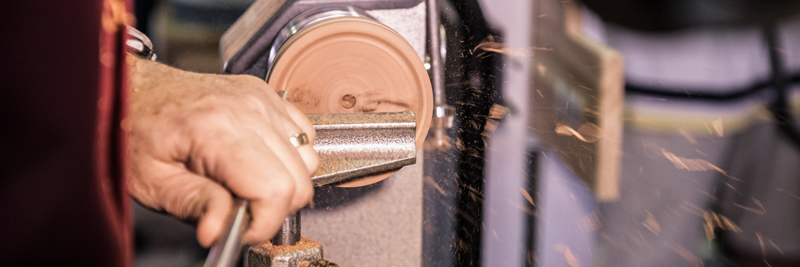When you first take up woodturning it’s possible and tempting to spend an enormous amount of money acquiring a comprehensive range of tools, chucks and accessories. However to get started it isn’t really necessary, you’re better to begin with a basic kit and go from there.

Where to start
Assuming you have acquired your lathe, you probably have the normal basic inclusions i.e. drive dog, small face-plate, live centre and knockout bar. These will allow you to turn spindle items and small bowls or boxes – if you have the appropriate turning chisels.
There are a number of pre-selected sets of turning tools available, however I recommend you start your collection by choosing just the basic tools. Here are my recommendations:
- 19mm Roughing Gouge
- 19mm Skew Chisel
- Diamond Profile Parting Tool
- 9.5mm Bowl Gouge
- 9.5mm Spindle Gouge
- 19mm Round Nose Scraper
An alternative to buying individual chisels is to select a packaged set of tools. These are the options that we stock at Carbatec:
Chucks
For versatility and safety it’s advisable to invest in a four-jaw chuck such as a Teknatool Super Nova at around $200 it represents great value and sets you up for developing further skills. You can also add a wide range of replaceable jaws to hold different shaped wood.
Sharpening
It’s important to work with “sharp” tools for both safety reasons and to ensure quality results. There are many ways of sharpening and every one will develop a preferred method. The starting point for most turners is a basic bench grinder with either 150mm grinding wheels or the larger version with 200mm wheels. The standard fitted grinding wheels will be suitable to get started. A good, solid chisel grinding jig mounted in front of the grinding wheels will assist in achieving a consistent bevel angle and a sharp cutting edge on your tools. Consider a Bench Grinder & Chisel Grinding Jig.
Dust
Dust safety is an important element of any woodwork activity and as a bare minimum you should use a quality disposable mask supported with a full face shield. Earmuffs are also a worthwhile safety investment. There are many options to upgrade to powered dust masks and face masks. Dust extraction or workshop vacuum systems should also be considered as an option.
Further basic items to make turning more enjoyable include:
Various Calipers:
- 200mm Caliper set; including inside, outside and divider
- Specialist thickness callipers and gauges can be added later
View our full range of woodturning tools here. For any advice or assistance on woodturning, please call your local Carbatec store or our Customer Care team. |